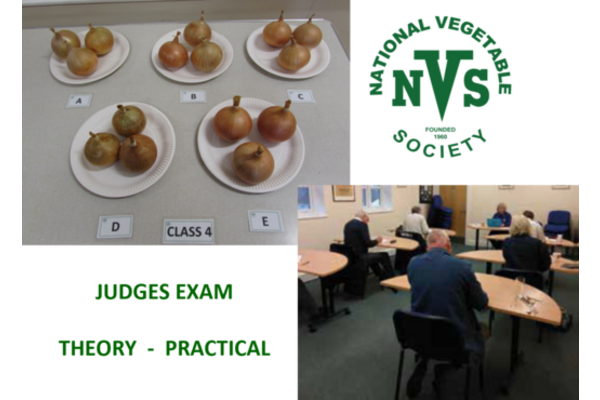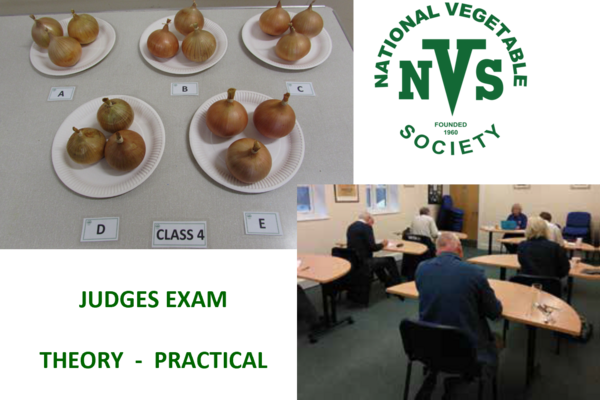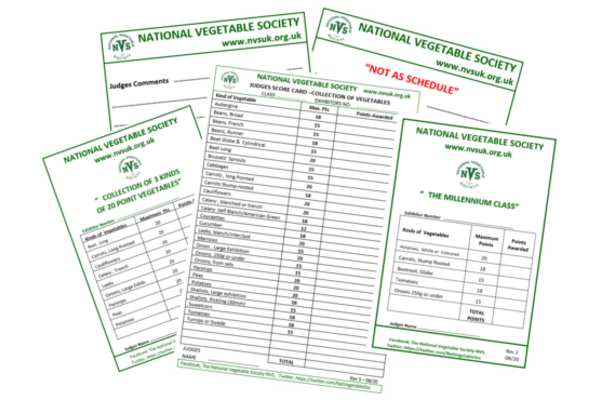Jim Williams, Chairman of the N.V.S Judges Examination Board
Introduction
The first point is that vegetable judging is not an exact science, certain criteria can be used, but at the end of the day personal opinion may prevail.
Prior to the formation of the N.V.S. the only attempt at standardising vegetable judging was that in in the R.H.S. Horticultural Show Handbook, there was no training or examination. In fact, one of the aims of those who founded the Society in 1960 was to improve the standard of vegetable judging. Since then, the N.V.S. has engaged in the training and examination of judges and has produced a “Judges Guide” for vegetables.
This has resulted in a national standard of vegetable judging which enables horticultural societies throughout the country to engage competent people to judge the vegetable sections at their shows.
Many years ago, judges were simply appointed from amongst experienced gardeners (mainly from estate gardens and park superintendents). Each gardener had his (and it was almost invariably his, not hers) own idea of what a winning leek or onion should look like. Inevitably this usually meant the bigger the better and quality, condition and uniformity were sometimes secondary factors.
Over the last thirty years (at least) newly qualified judges as a whole (there is always the odd maverick or exception) have been working to a clear range of criteria laid down in the Judges Guide. Now, vegetable exhibitors throughout Great Britain can put exhibits on the show bench knowing that their exhibits will receive uniform and fair appraisal. All judges are singing from the same hymn-sheet and using the same criteria. No matter whether you exhibit at the local village show or the N.V.S. National Championships your produce should receive the same appraisal, assuming the show organisers have appointed an N.V.S. certificated judge. However, judging is like refereeing a football match, there is always debate and sometimes controversy.
Judges MUST always be able to vindicate their decisions, and when a tight decision is being made, I find that if you can justify in your own mind how you would explain your decision to the second placed exhibitor, then you have made the correct decision. A good judge should always be present after judging if required to answer questions.
One must always assume that judges are honest, sometimes in the heat of the moment (or a senior moment) mistakes can be made. Nonetheless, with proper training and good use of the Judges Guide certificated N.V.S. judges do an excellent job at all shows.
What should a candidate expect when sitting the judge’s exam? When I sat my exam many years ago, I was not particularly keen on becoming a judge, I simply thought that if I could “think like a judge” I would be able to bench exhibits that fitted the judging criteria and therefore gain more first prizes. I think it helped to a certain extent, but it also made me aware what a difficult job judging is! It is not a job to be taken lightly, the responsibility is quite demanding, and if you wish to be a judge you must have thick skin and broad shoulders!
If you wish to sit the judge’s exam there are several rules that must be followed.
1 You must have been a member of the N.V.S. for at least one year.
2 You must have accompanied an experienced and ideally a certificated judge at several shows and be aware of schedules and general protocol.
3 You must have read, and have a good working knowledge of the N.V.S. Judges Guide.
In addition to these rules, it would be beneficial and indeed imperative to have a good background in general gardening and it would also be very helpful to have experience of exhibiting.
I have often heard it stated that good exhibitors make good judges, and over the years marking exam papers and looking at shows I can fully justify that statement. There is no doubt that if you grow and show vegetables you will have a much greater empathy with the judging principles. But there are lots of good judges who do not grow or show.
Each branch will nominate a “Moderator” who will be solely responsible for the overall running of the exam. The Moderator will be a branch official well versed in show and examination matters and will be responsible to the Examination Board.
The Moderator will
a) make sure all appropriate paper work is in place for both parts of the exam.
b) Appoint an invigilator for the theory exam.
c) Organise the provision (by others) of good quality vegetables for the practical exam.
d) Appoint two certificated “prejudges” to judge and point the practical exam.
e) The Moderator will be the only person present other than the candidates during the practical test.
f) The Moderator will observe, listen to and asses each candidate (in one class only) in order to form an opinion of their approach and ability. The Moderators observations will be noted on the candidate’s paper.
A Guide to assist the Moderator in assessing the candidate’s practical ability:
Box Marking:
1) Good, confident, well thought out explanation in reasonable time, gave the correct result.
2) Handles exhibits with authority and care, methodical.
3) Hesitant, slightly on the slow side, explanation vague.
4) Did not handle or lift all exhibits, failed to notice obvious faults.
5) Indecisive, “jittery”, no method, took too much time! Completely wrong result.
The Theory Paper
The Theory exam is normally held on the first Saturday of March and October in a venue in each of the five branches.
The exam paper is collated by the Judges Examination Board (Malcolm Evans, Ivor Mace and myself). The structure and content are very similar from year to year. An example past paper and answers has been provided for reference.
The paper is almost wholly based on the N.V.S Judges Guide, but in addition several questions depend on general knowledge of gardening, E.G. Chocolate Spot is a common problem of which vegetable.
E.G. Ghost Spot is a common problem of which vegetable.
One must have a good retention of the names of different cultivars; however, a candidate is not expected to memorise the guide, or to have a photographic memory. We try to avoid asking questions that simply require memorising lots of numbers.
Sections A, B, and C, are all compulsory with sections A and B worth 14 marks each, section C has 12 questions each worth 6 marks. This section always has a question on collection judging. Candidates are allowed 2 hours to complete the paper and we feel this is more than sufficient time.
Section A has a very simple tick box format where the candidate has 14 individual questions each worth 1 mark, and he /she ticks the correct box from a choice of 3 or 4 answers. Most candidates score highly in this section.
Section B contains 7 questions worth 2 marks each, there can be a wide variety of subjects in this section.
Section C has 12 questions most requiring an essay type answer, each is worth 6 marks.
The pass mark is 75% and over the years the pass rate has been very high. It is obvious that candidates from branches that hold “coaching” seminars score very highly in the theory paper.
The most common mistakes seen in the theory paper, are candidates giving “one word” answers e.g., yes or no. You cannot expect to score full marks unless you give a reasonably full answer. Where 2 marks are awarded for an answer, you must give two clear descriptive accounts to score full marks. We are looking for candidates to express themselves!
In some questions there are parts a and b, and sometimes candidates only answer part a, therefore losing valuable marks. It is important to read the question carefully to discover what you need to do.
The Practical Test.
This is usually held once a year in each branch.
The first section consists of eight individual classes (numbered 1-8), each comprising five dishes of vegetables e.g., stump carrots, onions from sets etc. they are labelled A, B, C, D and E. When setting up each class, the Moderator tries to make an obvious first and a clear fifth in each class. (In previous years we found that there was very little difference in some classes that the prejudges had difficulty in making decisions). The candidates will handle, examine and judge to find a 1st, 2nd ,3rd, and worst dish in each class, writing their results on the exam paper.
The second section is a deliberate fault class. There are three individual vegetables labelled 1, 2, and 3. Each vegetable will have a clear fault or faults e.g., celery with heart rot, and slug damage.
The candidate must identify and name the fault or faults, and the give a “FULL “account how the fault or faults could be prevented or cured. I emphasise that we are looking for a detailed answer, not one-word answers.
The third section is made up of two collections, (labelled A and B) usually staged on boards, comprising of five kinds of vegetables three specimens of each. Each dish must be pointed and the results written on the score sheets.
In order to give the candidates an indication of the prejudges scale of pointing, a separate individual dish e.g.; five potatoes white will be pointed by the prejudges, and will be available for the candidates to examine.
The two Prejudges judge the show before the candidates. They judge the eight classes together, making conjoint decisions.
They also judge the deliberate fault class together, noting their decisions.
They judge and point the collections independently, e.g.; judge no 1 may give long carrots 15 points, and judge 2 may give them 16 points.
When marking the practical, the candidates’ results are compared directly with those of the Prejudges, and obviously the nearer their decisions to the Prejudges results, the higher the marks scored.
The pass mark in the practical is also 75%, however we find the pass rate is much lower than the theory. There are several reasons why this occurs, it depends on the quality of the vegetables on show, the marking of the Prejudges and the experience or lack of in the candidates.







